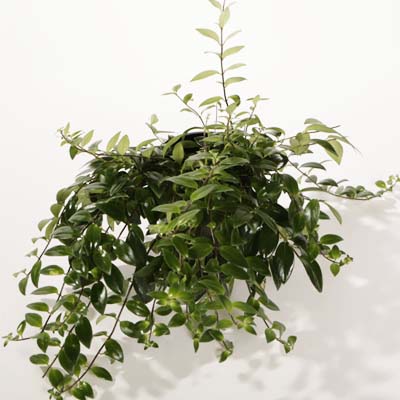Common Name: Lipstick Plant
Light Needs
Bright light
Water Requirements
Light watering
Description:
Often used as a hanging basket or tabletop display. Fleshy leaves pointed at both ends and growing in opposite pairs along the stem, which can grow to 2-feet-long.
Most commonly used varieties: Aeschynanthus longicaulis, Aeschynanthus ‘Cassiopeia’ and Aeschynanthus radicans ‘Krakau’
Often used as a hanging basket or tabletop display. Fleshy leaves pointed at both ends and growing in opposite pairs along the stem, which can grow to 2-feet-long. The decorative tubular, red flowers appear either singly or in pairs from the leaf axils or in clusters at the tips of stems. Typically lipsticks have a summertime flowering season indoors and the individual flowers last only two or three days. Aeschynanthus look their best when permitted to trail a bit. Put them on a plant stand. Let them cascade over the side of a shelf. They look great in a very tall container by themselves. Use lipsticks as ground cover, flowing over the side of pots. Displayed in these ways you can flaunt the flowers when it is in bloom and provide an optimum view of the wonderful foliage the rest of the year.
Aeschynanthus thrive in bright light, but don’t like much more than two or three hours of direct sunlight a day. Too much direct sun is not usually a problem in most interior situations! The best spot for most lipsticks is at an east- or west-facing window, where they will get a few hours a day of morning or afternoon sunlight. An Aeschynanthus in a south window might need to have the light filtered through a window shade or curtain.
When an Aeschynanthus is flowering, you’ll want to water it plentifully. Otherwise, water just enough to moisten the entire potting mixture. Allow the top half-inch to dry out between watering. Too little water will cause the oldest leaves to turn yellow. Inside, these plants do not have a rest period so they will require this much water all year long.
Aeschynanthus in inadequate light will result in weak, spindly stems and no flowers; so do not put them in the darkest areas. Use a balanced liquid fertilizer to achieve nice results twice per month, spring through fall. The roots of these plants are easily damaged by excess amounts of fertilizer, so use less than is recommended on the label. Pinch back the tips to encourage the plant to produce flower buds. Hint: if your foliage is turning purple, it needs a dose of fertilizer. Pinch those tips to keep them shapely and blooming. They tend to bloom from the cut point, so pinch frequently.
In the wild, Aeschynanthus are accustomed to warm temperatures with little fluctuations. This makes normal room and office temperatures just fine for them. A little extra humidity helps especially when the plant is flowering so you can give them a very fine, light spritz with your spray bottle every now and then.

